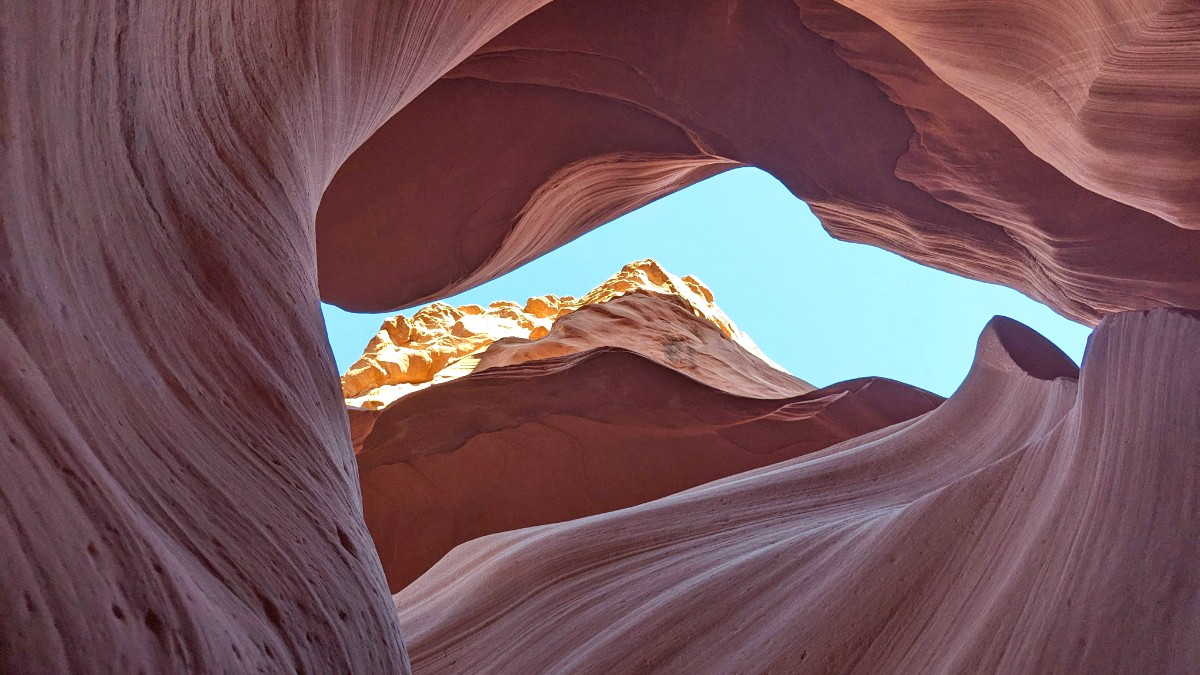
Arizona, USA
Upper Antelope Canyon (Tsé bighánílíní): The most famous section, known for incredible light beams especially from late March to early October during mid-day hours (10:00 AM - 2:00 PM). The canyon floor is relatively flat and sandy.
Lower Antelope Canyon (Hazdistazí): This section gives a more adventurous experience. It is narrower, needing visitors to navigate steep ladders and stairs to descend and ascend. The canyon's V-shape creates unique light and shadow plays.
Do not approach the edge too closely at Horseshoe Bend; no railings in many spots.
Flat, sandy floor. Famous light beams. Easy walk.
Steeper ladders, uneven steps. More adventurous. V-shape.
Less visited, intimate. Two distinct sections. Quieter.
Always book through authorized Navajo operators.
Use "vivid" or "warm" settings on camera for color.
While Page is small, it offers a few places to learn about the region's history and culture.
Provides information on Navajo tribal parks, including Antelope Canyon, Monument Valley, and Canyon de Chelly. Learn about Navajo culture, history, and land management.
Located on the Glen Canyon Dam. Features exhibits about the construction of the dam, the geology of the Colorado Plateau, the history of the Colorado River, and Lake Powell's significance. Views of the dam and Lake Powell.
These centers are resources for local information and understanding the region's unique heritage.
Explore exhibits detailing the natural and human history shaping the area.
These centers serve as excellent starting points for planning your visit to tribal lands and national recreation areas.
Gain a broader knowledge of the Colorado Plateau and its natural wonders.
A resource for understanding Navajo culture and tribal parks.
Learn about the Glen Canyon Dam's history and geology.
Both centers serve as information hubs for wider regional discovery.
The Page area's history ties to the landscape and significant engineering feats.
Beyond Antelope Canyon, the region is a playground of natural beauty.
The star of the show. Its unique slot canyon geology, with swirling, fluid sandstone walls and dramatic light effects, is a geological marvel.
The iconic horseshoe-shaped meander of the Colorado River, offering vast panoramic views.
This enormous reservoir is a destination in itself. It features thousands of miles of shoreline, countless coves, natural arches, and dramatic rock formations accessible by water.
Located south of Page, this vast and remote wilderness area protects colorful sandstone cliffs, canyons, and buttes. It is home to "The Wave," a famous sandstone formation that needs a highly competitive permit lottery to visit.
More info hereThe Desert View (East) Entrance to Grand Canyon's South Rim is about a 2.5-hour drive from Page.
Find toursOther areas are less restricted but still need careful planning and often high-clearance vehicles. This entrance offers different perspectives and viewpoints than the more crowded Grand Canyon Village.
You can see the Little Colorado River Gorge and the iconic Watchtower.
Known for early Mormon settlement attempts and as the starting point for Grand Canyon river expeditions.
While not prominently featured or easily accessible for public self-guided tours near Page, the Navajo Nation and surrounding areas hold numerous ancient sites.
Consider purchasing a National Parks Pass (America the Beautiful Pass) if you plan to visit multiple national parks or recreation areas like Glen Canyon National Recreation Area (Lake Powell) or the Grand Canyon.
It saves money on entrance fees and grants access to many federal sites.
Seek out these less-visited spots for unique perspectives and fewer crowds.
Several smaller, less-known slot canyons near Page give similar but often more private and less crowded experiences than main Antelope Canyon sections.
Stud Horse Point: A geological formation with unique sandstone hoodoos (pillar-like rock formations).
Offers an unique and less crowded slot canyon experience, with some tours including a short hike to a picturesque arch.
A great alternative to the main Antelope Canyon tours.
A geological formation featuring unique sandstone hoodoos. It has beautiful, unobstructed views of the surrounding desert.
A serene spot for desert contemplation.
A remote overlook giving stunning panoramic views of Lake Powell. It needs a high-clearance 4x4 vehicle for access.
Worth the effort for the expansive vistas.
Consider purchasing a National Parks Pass (America the Beautiful Pass) if you plan to visit multiple national parks or recreation areas like Glen Canyon National Recreation Area (Lake Powell) or the Grand Canyon.
It saves money on entrance fees and grants access to many federal sites, making it a valuable asset for extensive travel.
This pass supports broader exploration of the US national park system, a good choice for travelers touring multiple locations.